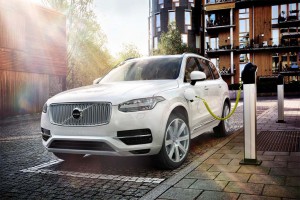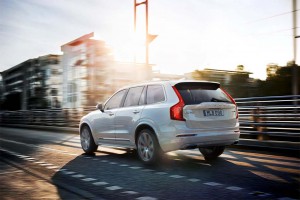
The Volvo XC90's plug-in drive will allow it to launch from 0 to 62 in 5.9 seconds - and yield 25 miles on battery power alone.
Volvo is out to prove that an SUV can be environmentally friendly – and still be a lot of fun to drive.
The maker is offering a first look at the new XC90 T8, a plug-in version of its next-generation SUV that it expects to deliver high fuel economy, low emissions and near sports car-like performance, with 0 to 100 kmh (0 to 62 mph) launch times of just 5.9 seconds.
“The XC90 T8 is a plug-in electric car, hybrid car and high-performance car rolled into one,” explains R&D chief Peter Mertens. “The Drive-E engines already offer highly competitive performance versus the competition. The T8 takes it further into a leading position.”
The upcoming launch of the next-generation Volvo XC90 marks a critical transition for Volvo. For one thing, the ute is based on the maker’s all-new Scalable Product Architecture – think flexible platform – that will be used for a wide range of upcoming sedans, wagons and SUVs. It also brings to market the full range of Volvo’s new Drive-E powertrains.
(Volvo aiming to create unique niche for new V60 Cross Country. Click Here for a closer look.)
In a risky move, the Swedish automaker is abandoning its old 5- and 6-cylinder powertrains in favor of a new range of 4-cylinder gasoline and diesel alternatives. And where some makers are looking to “electrified” options targeting their most green-minded buyers, Volvo is betting it can sell a plug-in to both those who want high mileage as well as its more performance-oriented customers.
The main source of power is a 2.0-liter, 4-cylinder Drive-E gas engine that is both turbocharged and supercharged. While not entirely unique, the approach provides solid torque and power across a wide rev range, reaching a peak of 318 horsepower and 295 pound-feet of torque. Power is directed to the front wheels through an 8-speed automatic gearbox.
There are two key parts to the electric side of the drivetrain, starting with a crankshaft-mounted starter-generator that puts out 34 kilowatts, or 46-hp, and 110 lb-ft of torque. Think of it as an additional electric supercharger, adding almost instantaneous, wheel-spinning torque.
Meanwhile, a larger 82-hp electric motor is tied to the rear wheels. It makes a solid 177 lb-ft of torque that is accessed during both pure electric and “power boost” modes. It also creates what is sometimes called a through-the-road all-wheel-drive system.
The T8’s 65 kilowatt-hour lithium-ion battery pack is tucked into the tunnel space that would normally be used for a driveshaft. That creates several advantages, Volvo claims. For one thing, it means there’s no impact on passenger or cargo space. It also helps improve the overall vehicle’s center of gravity.
(Plunging fuel prices creating challenge for hybrids, battery car sales. Click Herefor more.)
The system is designed to operate “seamlessly,” Volvo claims, meaning that but for a sudden lack of noise from the internal combustion engine, a driver might not notice when the Volvo XC90 T8 switches to pure battery power.
It can be switched into five different operating modes:
- There’s a default hybrid mode that is meant to balance performance and fuel economy;
- In pure electric mode, the rear motor serves as the sole energy source, though the gas engine will automatically fire up if more power is needed;
- For drivers who want maximum acceleration, the electric engine is programmed to enhance low-end torque, “equivalent to that of a large displacement engine like the V-8,” Volvo claims;
- In AWD mode, the XC90 T8 offers all-wheel torque distribution when and as needed;
- The Save mode allows a motorist to maintain the current level of battery charge for use later.
That mode could be useful to those who commute to cities, like London, which might waive congestion charges for electric vehicles – or ban internal combustion engines entirely. According to preliminary ratings, the XC90 T8 will produce just 59 grams of CO2 per kilometer, which should suggest something approaching 95 mpg – at least in the European test cycle. The U.S. EPA rating would likely be significantly lower but still should be impressive for an SUV the size of the XC90.
Among other things, the new XC90 T8 will be equipped with the latest Volvo infotainment system and, using the On Call app, it will allow motorists to pre-condition the cabin to just the right temperature before they climb inside.
(Volvo will build new top-range S90 sedan in China, maker reveals. Click Here for the story.)


I need someone smarter than me to explain how these instant start/stop systems operate. It cannot be a bendix actuated starter like most cars have had in the past – they wouldn’t last in an on/off mode for 20k miles, let alone 100k. What method is being used to get these systems to be so flexible? Also, how do they harvest the electricity at braking? I looked at a Prius closely yesterday, and nothing obvious is staring at me except a caliper.
Hi, Raymond,
There are a variety of different Stop/Start technologies. Some are mild hybrid, using separate motors, other beef up the existing starter motors so that they are quicker and more robust than a conventional starter motor.
Here’s one useful link: http://auto.howstuffworks.com/fuel-efficiency/hybrid-technology/idle-stop-system.htm
As to hybrid braking systems, they’re normally what is known as a “blended” braking system that includes both a conventional brake and a generator system that recaptures energy. The idea is that under normal braking the generator system does primary work, turning kinetic energy into electrical energy. When you brake more aggressively or the generator/brake reaches maximum capacity the mechanical brake system takes over.
Paul A. Eisenstein
Publisher, TheDetroitBureau.com